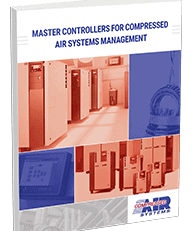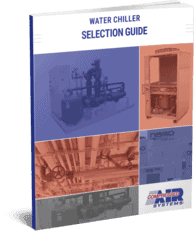5 Benefits of Compressed Air Energy Storage
Compressed air energy storage (CAES) offers a method for storing compressed air within a sealed enclosure. Storage in a compressed air system allows users to supplement energy usage during high-demand periods, enhances air quality, and maintains system stability. The energy is recovered by allowing the air to decompress through a turbine. Heat that is released during expansion can be reused for added energy efficiency.
What is Compressed Air Energy Storage?
 CAES can be used for large-scale energy storage, in which the air is stored in pressurized storage tanks or underground caverns. Pressurized air is pumped into the enclosure using a compressor and stored until the energy is needed. The stored energy is retrieved by allowing the air to expand, which pushes high-pressure air through a turbine to create electricity.
CAES can be used for large-scale energy storage, in which the air is stored in pressurized storage tanks or underground caverns. Pressurized air is pumped into the enclosure using a compressor and stored until the energy is needed. The stored energy is retrieved by allowing the air to expand, which pushes high-pressure air through a turbine to create electricity.
The expanding air cools significantly and must be heated before it is passed through the turbine. This can be affected using either diabatic or adiabatic methods.
- The diabatic method uses fuel to heat the air prior to discharging it into the turbine.
- The adiabatic technique stores heat generated during the initial compression phase and applies that heat to the air during expansion, thereby increasing the air temperature without expending any additional energy.
The adiabatic method is more energy efficient and is also emission-free, but the process requires advanced thermal storage techniques that are not readily available. A number of isothermal CAES methods are currently being researched as a means to control the heating and cooling processes in a more energy-efficient fashion.
Benefits of Compressed Air Energy Storage
CAES offers a broad range of benefits for energy storage in a variety of applications. The five key benefits of CAES include energy savings, better air quality, improved pressure stability, reduced maintenance costs, and enhanced compressor service life.
Increased Energy Savings
CAES is used to enhance storage for peak demand periods, thereby reducing the load on the electrical grid. This allows energy companies to provide sufficient energy for the entire service area without the need for added energy production during peak usage. Used on a smaller scale, CAES can reduce dependency on the electrical grid, thereby reducing energy charges and operational overhead. In addition, CAES stores pressurized air, mitigating the need purchase and power a completely separate compressor.
Enhanced Air Quality
CAES produces significantly lower CO2 emissions than other energy production methods. Using adiabatic processes, emissions can be reduced to nearly zero. Coupled with reduced reliance on fossil fuel-powered grids, CAES offers an eco-friendly energy solution.
Improved System Stability
The use of CAES as a supplemental energy source helps to enhance power grid stability during peak times or surges in electrical use. This places less strain on the electrical infrastructure and helps to reduce emissions and improve energy reliability. For smaller scale operations, compressed air energy storage allows for more reliable and stable electrical production.
Reduced Maintenance Costs
CAES systems require very little maintenance when compared with other energy production methods. When used in small-scale energy production, compressed air storage reduces compressor maintenance frequency, which in turn reduces maintenance costs.
Extended Air Compressor Lifetime
Since CAES systems store compressed air, the compressor does not have to run as frequently. This reduces overall wear on the compressor and extends its service life. Storage of compressed air also allows the compressor to fully unload before it has to start again and reduces short cycling. The control strategy for CAES systems can be further simplified through the sequencing of multiple compressors.
More on Compressed Air Energy Storage
History of Compressed Air Energy Storage
CAES was originally established at a plant in Huntorf, Germany in 1978. The plant is still operational today, and has a capacity of 290 MW. The compressed air is stored in underground in retired salt mines and used to supplement the energy grid during peak usage. The only other large scale CAES plant in the world was established in 1991 in McIntosh, Alabama. This system also uses underground salt caverns for compressed air storage, and has a capacity of 110 MW.
Although excavated salt mining caverns are not readily available in all geographic locations, recent research has shown that other formations of porous and permeable rock may serve the same purpose. Scientists hope to expand the use of CAES from load-shifting to a more active source of large-scale clean energy production. In addition, engineers are already working on technology to expand the use of CAES for small-scale, off-grid operations.
How Does Compressed Air Energy Storage Work?
The CAES process is relatively simple, though it requires highly specialized equipment. Electricity from the public electrical grid or renewable power sources is used to power a compressor, which pumps air into a storage container. For large scale power storage, the pressurized air is stored in underground caverns, but small scale operations may store compressed air in specialized storage tanks. When electricity is needed, the compressed air is released from the holding tank and heated using either stored heat from the compression process or heat generated from burning fossil fuels. The compressed air expands quickly, passing through the turbine to generate electricity.
The amount of energy held by the compressed air is based on the density of the air. The cavern or storage tank must therefore be capable of withstanding the extreme pressure and air density. For this reason, strong and durable carbon fiber is typically used to store compressed air in small scale CAES operations.
Compressed Energy Storage Solutions From Compressed Air Systems
Compressed Air Systems offers a range of air compressors and storage systems to meet your operational needs. Adequately sized compressed air storage tanks can offer low-cost energy production without the need to operate another compressor. To learn more about our compressed air energy storage solutions, please contact us today.










